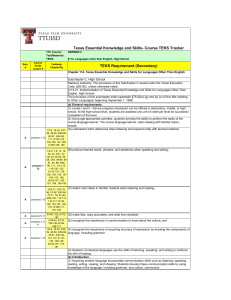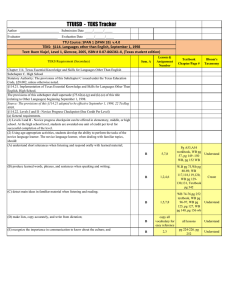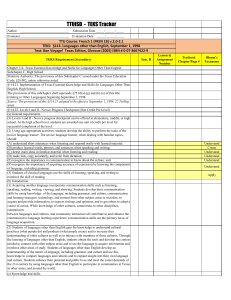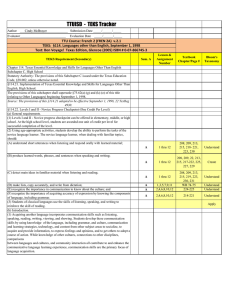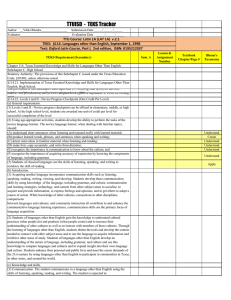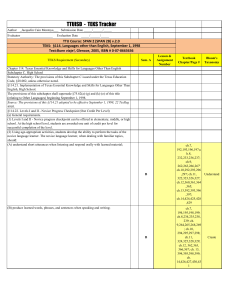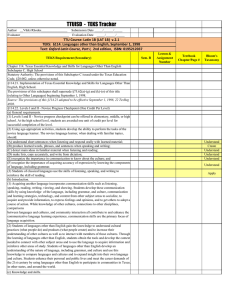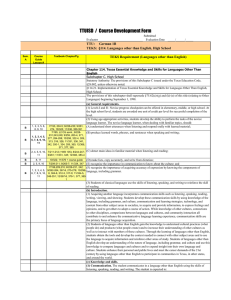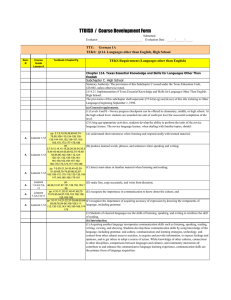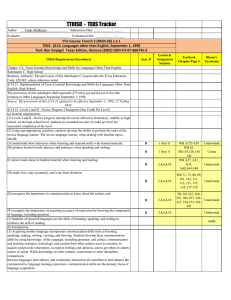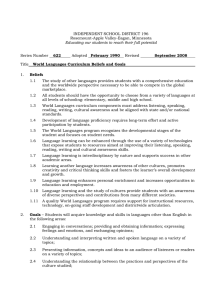TTUISD - TEKS Tracker
advertisement
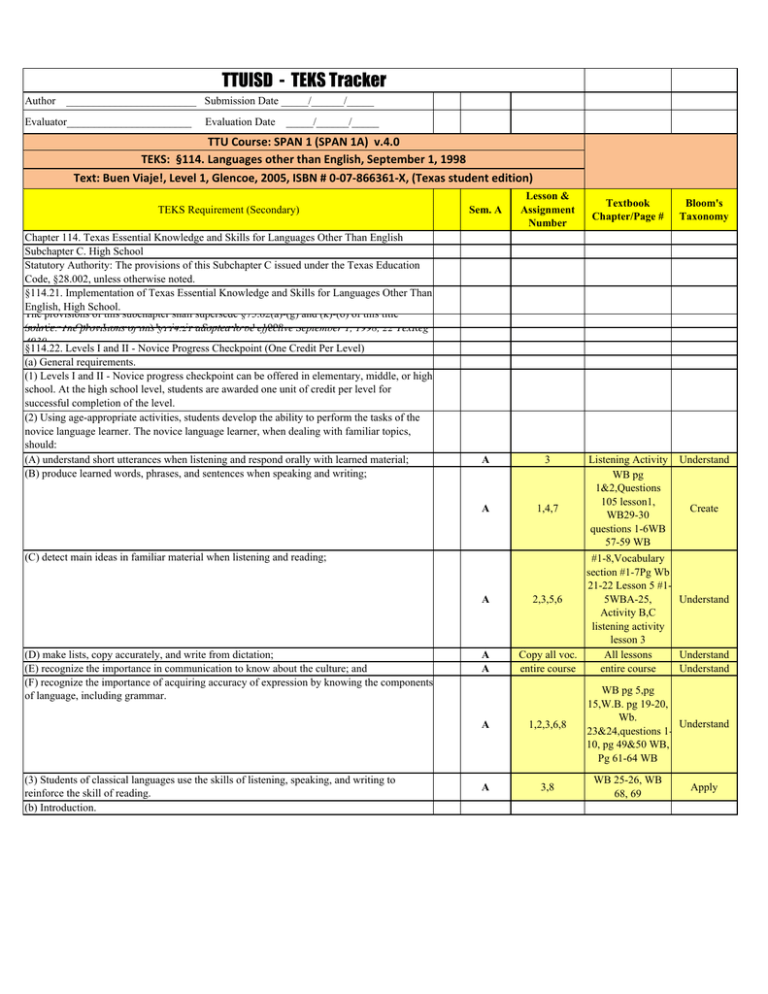
TTUISD - TEKS Tracker Author ________________________ Submission Date _____/______/_____ Evaluator_______________________ Evaluation Date _____/______/_____ TTU Course: SPAN 1 (SPAN 1A) v.4.0 TEKS: §114. Languages other than English, September 1, 1998 Text: Buen Viaje!, Level 1, Glencoe, 2005, ISBN # 0‐07‐866361‐X, (Texas student edition) TEKS Requirement (Secondary) Chapter 114. Texas Essential Knowledge and Skills for Languages Other Than English Subchapter C. High School Statutory Authority: The provisions of this Subchapter C issued under the Texas Education Code, §28.002, unless otherwise noted. §114.21. Implementation of Texas Essential Knowledge and Skills for Languages Other Than English, High School. The provisions of this subchapter shall supersede §75.62(a)-(g) and (k)-(o) of this title (relatingThe to Other Languages) September 1998 September 1, 1998, 22 TexReg Source: provisions of this beginning §114.21 adopted to be1 effective 4930 §114.22. Levels I and II - Novice Progress Checkpoint (One Credit Per Level) (a) General requirements. (1) Levels I and II - Novice progress checkpoint can be offered in elementary, middle, or high school. At the high school level, students are awarded one unit of credit per level for successful completion of the level. (2) Using age-appropriate activities, students develop the ability to perform the tasks of the novice language learner. The novice language learner, when dealing with familiar topics, should: (A) understand short utterances when listening and respond orally with learned material; (B) produce learned words, phrases, and sentences when speaking and writing; Sem. A Lesson & Assignment Number A 3 A (C) detect main ideas in familiar material when listening and reading; A (D) make lists, copy accurately, and write from dictation; (E) recognize the importance in communication to know about the culture; and (F) recognize the importance of acquiring accuracy of expression by knowing the components of language, including grammar. (3) Students of classical languages use the skills of listening, speaking, and writing to reinforce the skill of reading. (b) Introduction. A A Textbook Chapter/Page # Listening Activity WB pg 1&2,Questions 105 lesson1, 1,4,7 WB29-30 questions 1-6WB 57-59 WB #1-8,Vocabulary section #1-7Pg Wb 21-22 Lesson 5 #15WBA-25, 2,3,5,6 Activity B,C listening activity lesson 3 Copy all voc. All lessons entire course entire course A 1,2,3,6,8 A 3,8 Bloom's Taxonomy Understand Create Understand Understand Understand WB pg 5,pg 15,W.B. pg 19-20, Wb. Understand 23&24,questions 110, pg 49&50 WB, Pg 61-64 WB WB 25-26, WB 68, 69 Apply TEKS Requirement (Secondary) Sem. A Lesson & Assignment Number Textbook Chapter/Page # Bloom's Taxonomy (1) Acquiring another language incorporates communication skills such as listening, speaking, reading, writing, viewing, and showing. Students develop these communication skills by using knowledge of the language, including grammar, and culture, communication and learning strategies, technology, and content from other subject areas to socialize, to acquire and provide information, to express feelings and opinions, and to get others to adopt a course of action. While knowledge of other cultures, connections to other disciplines, comparisons between languages and cultures, and community interaction all contribute to and enhance the communicative language learning experience, communication skills are the primary focus of language acquisition. (2) Students of languages other than English gain the knowledge to understand cultural practices (what people do) and products (what people create) and to increase their understanding of other cultures as well as to interact with members of those cultures. Through the learning of languages other than English, students obtain the tools and develop the context needed to connect with other subject areas and to use the language to acquire information and reinforce other areas of study. Students of languages other than English develop an understanding of the nature of language, including grammar, and culture and use this knowledge to compare languages and cultures and to expand insight into their own language and culture. Students enhance their personal and public lives and meet the career demands of the 21st century by using languages other than English to participate in communities in Texas, in other states, and around the world. (c) Knowledge and skills. (1) Communication. The student communicates in a language other than English using the skills of listening, speaking, reading, and writing. The student is expected to: (A) engage in oral and written exchanges of learned material to socialize and to provide and obtain information; (B) demonstrate understanding of simple, clearly spoken, and written language such as simple stories, high-frequency commands, and brief instructions when dealing with familiar topics; and (C) present information using familiar words, phrases, and sentences to listeners and readers. (2) Cultures. The student gains knowledge and understanding of other cultures. The student is expected to: (A) demonstrate an understanding of the practices (what people do) and how they are related to the perspectives (how people perceive things) of the cultures studied; and (B) demonstrate an understanding of the products (what people create) and how they are related to the perspectives (how people perceive things) of the cultures studied. (3) Connections. The student uses the language to make connections with other subject areas and to acquire information. The student is expected to: (A) use resources (that may include technology) in the language and cultures being studied to gain access to information; and (B) use the language to obtain, reinforce, or expand knowledge of other subject areas. (4) Comparisons. The student develops insight into the nature of language and culture by comparing the student's own language and culture to another. The student is expected to: (A) demonstrate an understanding of the nature of language through comparisons of the student's own language and the language studied; (B) demonstrate an understanding of the concept of culture through comparisons of the student's own culture and the cultures studied; and (C) demonstrate an understanding of the influence of one language and culture on another. WB pg 7,speaking part lesson 4 speaking part, lesson 6 speaking part WBpg11-12 #122pg 122 textbook, WB pg 151, WB pg A-28 WB, pg 60, WB pg 70 speaking part, pg. 28, pg 145 WB A 1,2,4,6 A 1,4,6,7,8 A 3,5 A Preliminary chapter, lesson5 pg 107,120, Wbpg 29,30-31 preliminary chapter pg 4 Apply A 3 pg 62, 92 Apply A 4 pg 35-36 WB Apply A 2 pg 67 Apply A 1,6 A 4 A 3 pg 23, in textbook 158 in Workbook pg 81, 90. 92, 96 in textbook pg 62, 63 Create Apply Create Apply Apply Apply TEKS Requirement (Secondary) (5) Communities. The student participates in communities at home and around the world by using languages other than English. The student is expected to: (A) use the language both within and beyond the school setting through activities such as participating in cultural events and using technology to communicate; and (B) show evidence of becoming a lifelong learner by using the language for personal enrichment and career development. Source: The provisions of this §114.22 adopted to be effective September 1, 1998, 22 TexReg 4930. Sem. A Lesson & Assignment Number Textbook Chapter/Page # Bloom's Taxonomy A 3,4,5 pg 97, pg 101, pg 149 Apply A 1-8 chapters 1-6 Analyze
